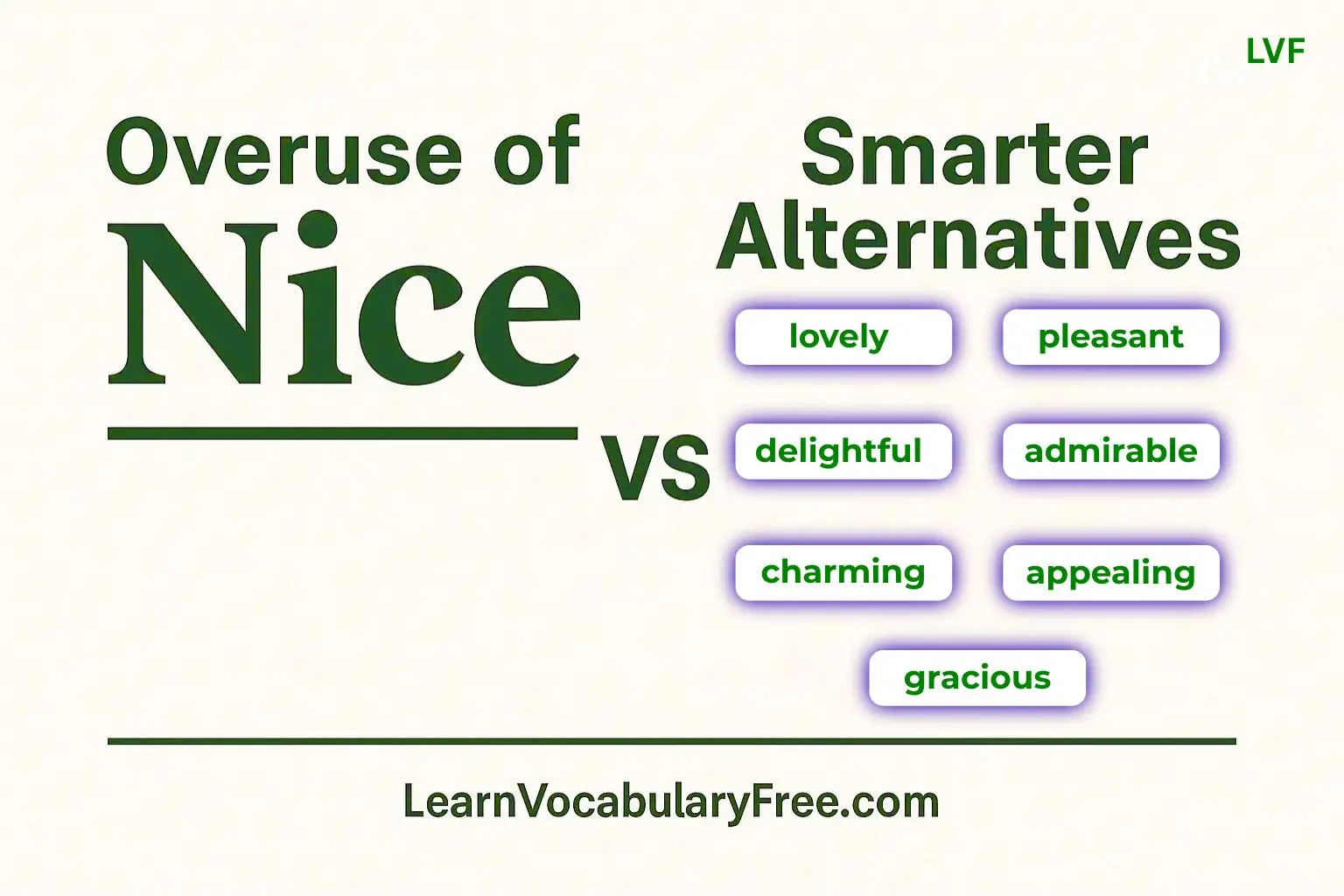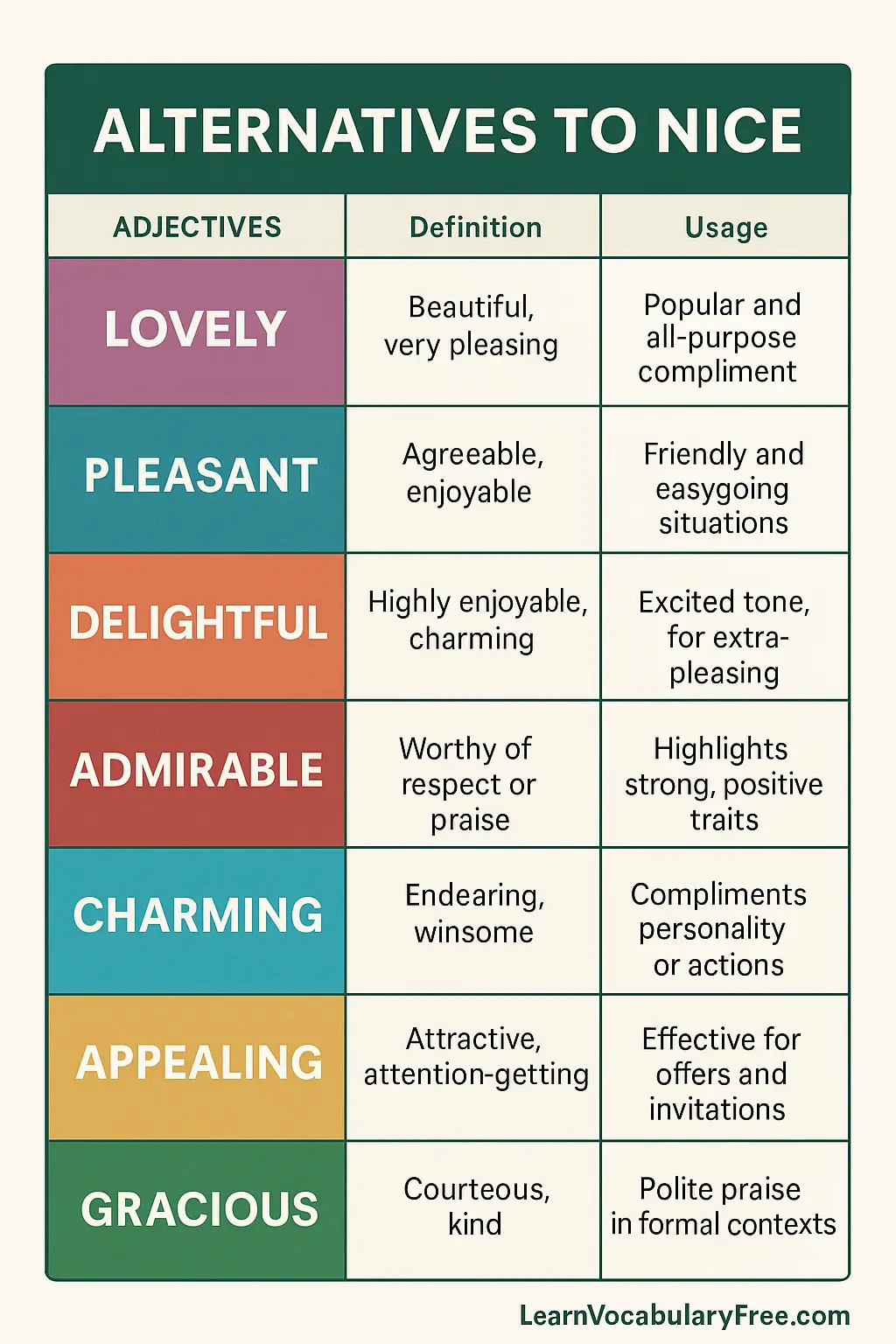Overuse of Nice: 7 Smarter Alternatives for Everyday English
If the Overuse of Nice keeps slipping into your emails and essays, you’re not alone. Here’s how to replace it with precise, powerful language.

Why the Overuse of Nice Hurts Your Expression
Relying on nice makes your language sound vague. Readers can’t tell if something is polite, pleasant, impressive, or truly praiseworthy. That lack of precision reduces clarity, impact, and credibility—especially in academic, professional, and test contexts.
What “Nice” Fails to Do (and When to Avoid Overused Words)
It Blurs Meaning
“Nice” could mean friendly, visually appealing, well-done, or acceptable—but which? Overused words hide your real evaluation.
It Causes Reader Fatigue
Repetition dulls attention. Specific, varied adjectives keep readers engaged and help ideas land.
It Underserves Professional & Test Contexts
In reports, emails, and essays (SAT/IELTS/TOEFL), precise vocabulary signals control and clarity—traits “nice” rarely conveys.
Why We Default to the Overuse of Nice
Habit and the “Safe Choice”
We reach for familiar words under time pressure. That’s normal—but fixable.
Limited Ready-to-Use Alternatives
Without a small bank of stronger words, we fall back on “nice.”
Early Reinforcement
“Nice job!” is praised from childhood—so it persists into adult writing.
7 Smarter Alternatives to Nice (With Usage Notes)
Lovely — warm & pleasing
- Use for people, experiences, and aesthetics that feel genuinely pleasant.
- Polite tone; works in social and semi-formal contexts.
Example: “Thanks for a lovely evening—the conversation was great.”
Pleasant — agreeable & comfortable
- Neutral-polite; good for meetings, environments, or interactions.
- Safe for HR notes, customer support, or official emails.
Example: “It was a pleasant discussion with actionable next steps.”
Delightful — genuinely enjoyable
- Stronger than “pleasant”; conveys joy and positive surprise.
- Great for reviews, recommendations, and feedback.
Example: “Your keynote was delightful—engaging, clear, and memorable.”
Admirable — worthy of respect
- Use for character, effort, or values rather than looks.
- Professional tone; powerful in recommendations and reports.
Example: “Her persistence is admirable, especially under pressure.”
Charming — attractively engaging
- Use for people, places, or small details with personality.
- Friendly tone; avoid in highly formal documents.
Example: “The café has a charming interior with thoughtful touches.”
Appealing — attractive or convincing
- Good for proposals, designs, and product features.
- Objective-leaning; fits presentations and executive summaries.
Example: “The revised layout is highly appealing to first-time users.”
Gracious — courteous & considerate
- Use for behavior, hospitality, and tone in communication.
- Excellent for thank-you notes and professional etiquette.
Example: “He was gracious in acknowledging everyone’s contributions.”

How to Choose the Best Alternative (Improve Vocabulary Expression)
Match the Intent
Is it warmth, respect, attractiveness, or persuasion? Pick the word that reflects your purpose.
Consider Tone and Audience
Admirable suits formal reports; charming fits casual reviews; appealing works for product language.
Lead with Evidence
Support praise with specifics: data, outcomes, features, or behaviors.
Avoid Overused Words in Writing: Break the Habit in 7 Days
- Track every “nice” you write.
- Replace each instance with a precise alternative.
- Build a seven-word “better than nice” bank.
- Review emails before sending—swap vague phrases.
- Revise a past paragraph purely for precision.
- Collect examples from high-quality sources.
- Repeat weekly; keep what feels natural.
Helpful Resources (Internal & External)
🧠 Overuse of Very Good — Better Adjectives for Precise Praise
Upgrade from “very good” to excellent, superb, outstanding, exceptional, and more.
🧠 LVF SAT Words Expressing Positivity & Generosity: Stronger Words than “Nice”
Explore uplifting your vocabulary that captures warmth, kindness, and appreciation—words like affable, benevolent, magnanimous, gracious, and resplendent—ideal for replacing overused terms like “nice.”
📖 Definition of “Nice” by Cambridge Dictionary
See meanings, pronunciation, and usage examples to pick the right tone.
🔎 Thesaurus for “Nice” by Merriam-Webster
Explore synonyms like pleasant, agreeable, delightful with nuance and context.
Conclusion: Retire the Overuse of Nice and Be Precise
Precision beats repetition. Swap “nice” for targeted adjectives and your communication becomes clearer, more persuasive, and more professional.
Try it now: revise one paragraph and replace every “nice” with a stronger, context-true alternative.
